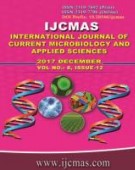


 National Academy of Agricultural Sciences (NAAS)
National Academy of Agricultural Sciences (NAAS)

|
PRINT ISSN : 2319-7692
Online ISSN : 2319-7706 Issues : 12 per year Publisher : Excellent Publishers Email : editorijcmas@gmail.com / submit@ijcmas.com Editor-in-chief: Dr.M.Prakash Index Copernicus ICV 2018: 95.39 NAAS RATING 2020: 5.38 |
Quantitative real-time polymerase chain reaction (qRT-PCR) is a low cost, rapid, accurate method for quantification of gene expression. Accuracy of qRT-PCR expression quantification is highly dependable on selected reference genes or miRNAs as these genes or miRNAs work as internal controls for normalization to quantify expression among different samples. Problems have been reported with steady expression or stability of reference genes in various conditions. Thus suitable reference genes or miRNAs need to be identified in various experimental conditions. The Cancer Genome Atlas (TCGA) Level 3 miRNA expression data for 11 cancers were collected, after pre-processing data from 4 cancers having 102 normal samples and 1428 tumor samples was used to find potential reference miRNA. Mean, coefficient of variation among normal and tumor samples were checked to find highly, stably expressed miRNAs between normal and tumor conditions. We found 32 potential qRT-PCR reference miRNAs in 3 out of 4 cancer types. 15 miRNA were found in cholangiocarcinoma (CHOL), 13 miRNA in kidney renal papillary cell carcinoma (KIRP) and 4 miRNA in stomach and esophageal carcinoma (STES). We did not find any miRNA passing all selection criteria in glioma (GBMLGG). In this study we used TCGA data to find potential qRT-PCR reference miRNAs in 4 cancers. We performed computational analysis of 1530 expression profiles of both normal and tumor conditions from 4 human cancer types and found total 32 stably and highly expressed potential reference miRNAs in 3 out of 4 cancer types. Data generated using next-generation sequencing (NGS) technologies can be very helpful in finding reference qRT-PCR miRNAs.
 |
 |
 |
 |
 |